A Spatiotemporal Constraint Non-Negative Matrix Factorization Model to Discover Intra-Urban Mobility Patterns from Taxi Trips
Abstract
1. Introduction
2. Brief Overview of NMF
3. Spatiotemporal Constraint NMF (STC-NMF) Model for Taxi Trips
3.1. Modeling Spatial and Temporal Dependencies in Taxi Trips
3.2. The STC-NMF Model
- (1)
- For the input matrix , initialize randomly two non-negative matrices, and , which satisfy and , respectively;
- (2)
- Update and iteratively by the multiplicative update algorithm until and are stable.
4. Case Study
4.1. Data Description and Preprocessing
4.2. Modeling
4.3. Discovering Spatiotemporal Mobility Patterns
4.3.1. Mobility Patterns During Weekdays
Departure Patterns During Weekdays
Arrival Patterns During Weekdays
4.3.2. Mobility Patterns During Weekends
Departure Patterns During Weekends
Arrival Patterns During Weekends
4.4. Spatial Interaction Patterns
4.5. Verification
5. Conclusions
Author Contributions
Funding
Conflicts of Interest
Appendix A
Appendix B
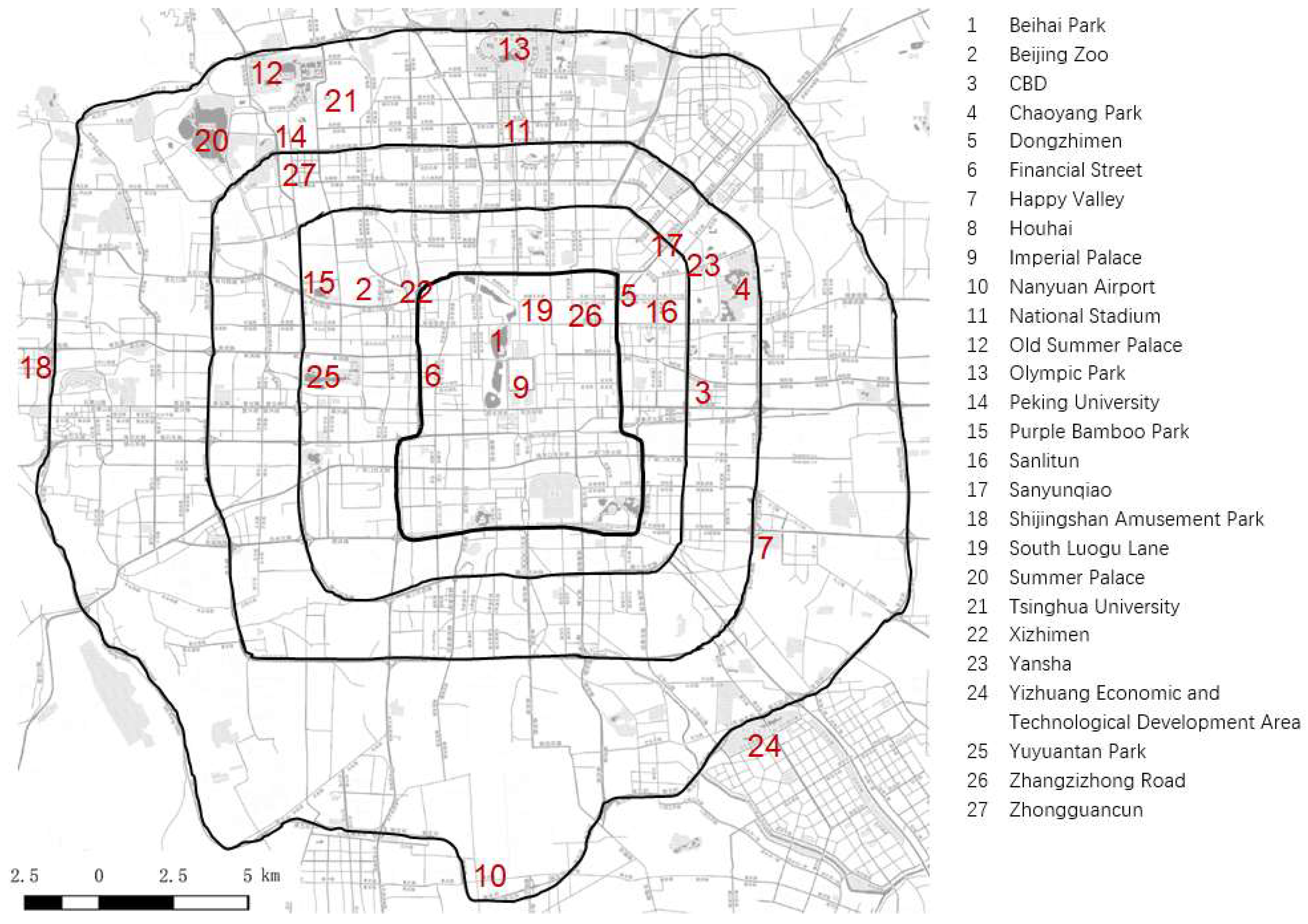
References
- Bruun, E.; Givoni, M. Sustainable mobility: Six research routes to steer transport policy. Nature 2015, 523, 29–31. [Google Scholar] [CrossRef] [PubMed]
- Gillis, D.; Semanjski, I.; Lauwers, D. How to monitor sustainable mobility in cities? Literature review in the frame of creating a set of sustainable mobility indicators. Sustainability 2016, 8, 29. [Google Scholar] [CrossRef]
- Jung, J.; Jayakrishnan, R.; Choi, K. Dually sustainable urban mobility option: Shared-taxi operations with electric vehicles. Int. J. Sustain. Transp. 2017, 11, 567–581. [Google Scholar] [CrossRef]
- Li, M.; Dong, L.; Shen, Z.; Lang, W.; Ye, X. Examining the interaction of taxi and subway ridership for sustainable urbanization. Sustainability 2017, 9, 242. [Google Scholar] [CrossRef]
- Nikulina, V.; Simon, D.; Ny, H.; Baumann, H. Context-adapted urban planning for rapid transitioning of personal mobility towards sustainability: A systematic literature review. Sustainability 2019, 11, 1007. [Google Scholar] [CrossRef]
- Zheng, Y. Trajectory data mining: An overview. ACM Trans. Intell. Syst. Technol. 2015, 6, 1–41. [Google Scholar] [CrossRef]
- Jiang, B.; Yin, J.; Zhao, S. Characterizing the human mobility pattern in a large street network. Phys. Rev. E 2009, 80, 021136. [Google Scholar] [CrossRef]
- Liu, Y.; Kang, C.; Gao, S.; Xiao, Y.; Tian, Y. Understanding intra-urban trip patterns from taxi trajectory data. J. Geogr. Syst. 2012, 14, 463–483. [Google Scholar] [CrossRef]
- Li, B.; Zhang, D.; Sun, L.; Chen, C.; Li, S.; Qi, G.; Yang, Q. Hunting or waiting? Discovering passenger-finding strategies from a large-scale real-world taxi dataset. In Proceedings of the IEEE International Conference on Pervasive Computing and Communications (PERCOM), Seattle, WA, USA, 21–25 March 2011; pp. 63–68. [Google Scholar] [CrossRef]
- Yuan, N.J.; Zheng, Y.; Zhang, L.; Xie, X. T-Finder: A recommender system for finding passengers and vacant taxis. IEEE Trans. Knowl. Data Eng. 2013, 25, 2390–2403. [Google Scholar] [CrossRef]
- Kang, C.; Qin, K. Understanding operation behaviors of taxicabs in cities by matrix factorization. Comput. Environ. Urban Syst. 2016, 60, 79–88. [Google Scholar] [CrossRef]
- Gao, Y.; Jiang, D.; Xu, Y. Optimize taxi driving strategies based on reinforcement learning. Int. J. Geogr. Inf. Sci. 2018, 32, 1677–1696. [Google Scholar] [CrossRef]
- Castro, P.S.; Zhang, D.; Chen, C.; Li, S.; Pan, G. From taxi GPS traces to social and community dynamics: A survey. ACM Comput. Surv. 2013, 46, 17. [Google Scholar] [CrossRef]
- Liu, X.; Gong, L.; Gong, Y.; Liu, Y. Revealing travel patterns and city structure with taxi trip data. J. Transp. Geogr. 2015, 43, 78–90. [Google Scholar] [CrossRef]
- Zhu, X.; Guo, D. Urban event detection with big data of taxi OD trips: A time series decomposition approach. Trans. GIS 2017, 21, 560–574. [Google Scholar] [CrossRef]
- Hu, Y.; Miller, H.J.; Li, X. Detecting and analyzing mobility hotspots using surface networks. Trans. GIS 2014, 18, 911–935. [Google Scholar] [CrossRef]
- Guo, D.; Zhu, X.; Jin, H.; Gao, P.; Andris, C. Discovering spatial patterns in origin-destination mobility data. Trans. GIS 2012, 16, 411–429. [Google Scholar] [CrossRef]
- Peng, C.; Jin, X.; Wong, K.-C.; Shi, M.; Liò, P. Collective human mobility pattern from taxi trips in urban area. PLoS ONE 2012, 7, e34487. [Google Scholar] [CrossRef]
- Scholz, R.W.; Lu, Y. Detection of dynamic activity patterns at a collective level from large-volume trajectory data. Int. J. Geogr. Inf. Sci. 2014, 28, 946–963. [Google Scholar] [CrossRef]
- Gong, L.; Liu, X.; Wu, L.; Liu, L. Inferring trip purposes and uncovering travel patterns from taxi trajectory data. Cartogr. Geogr. Inf. Sci. 2015, 43, 103–114. [Google Scholar] [CrossRef]
- Wang, P.; Fu, Y.; Liu, G.; Hu, W.; Aggarwal, C. Human mobility synchronization and trip purpose detection with mixture of hawkes processes. In Proceedings of the KDD’17, Halifax, NS, Canada, 13–17 August 2017. [Google Scholar] [CrossRef]
- Zhan, X.; Ukkusuri, S.; Yang, C. A Bayesian mixture model for short-term average link travel time estimation using large-scale limited information trip-based data. Autom. Constr. 2016, 72, 237–246. [Google Scholar] [CrossRef]
- Zheng, Z.; Zhou, S. Scaling laws of spatial visitation frequency: Applications for trip frequency prediction. Comput. Environ. Urban Syst. 2017, 64, 332–343. [Google Scholar] [CrossRef]
- Liu, X.; Kang, C.; Gong, L.; Liu, Y. Incorporating spatial interaction patterns in classifying and understanding urban land use. Int. J. Geogr. Inf. Sci. 2016, 30, 334–350. [Google Scholar] [CrossRef]
- Zhang, W.; Qi, G.; Pan, G.; Lu, H.; Li, S.; Wu, Z. City-scale social event detection and evaluation with taxi traces. ACM Trans. Intell. Syst. Technol. 2015, 6, 40. [Google Scholar] [CrossRef]
- Lee, D.D.; Seung, H.S. Learning the parts of objects by non-negative matrix factorization. Nature 1999, 401, 788–791. [Google Scholar] [CrossRef] [PubMed]
- Berry, M.W.; Browne, M.; Langville, A.N.; Pauca, V.P.; Plemmons, R.J. Algorithms and Applications for Approximate Nonnegative Matrix Factorization. Comput. Stat. Data Anal. 2007, 52, 155–173. [Google Scholar] [CrossRef]
- Gillis, N. The why and how of nonnegative matrix factorization. In Regularization, Optimization, Kernels, and Support Vector Machines 2014; Suykens, J., Signoretto, M., Argyriou, A., Eds.; Chapman & Hall/CRC: Boca Raton, FL, USA, 2014; pp. 257–291. [Google Scholar]
- Guillamet, D.; Vitrià, J. Non-negative matrix factorization for face recognition. In Lecture Notes in Artificial Intelligence; Escrig, M.T., Toledo, F., Golobardes, E., Eds.; Springer: Berlin/Heidelberg, Germany, 2002; Volume 2504, pp. 336–344. [Google Scholar] [CrossRef]
- Arora, S.; Ge, R.; Halpern, Y.; Mimno, D.; Moitra, A.; Sontag, D.; Wu, Y.; Zhu, M. A Practical Algorithm for Topic Modeling with Provable Guarantees. In Proceedings of the 30th International Conference on Machine Learning, Atlanta, GA, USA, 16–21 June 2013; pp. 280–288. [Google Scholar]
- Bell, R.; Koren, Y.; Volinsky, C. Matrix factorization techniques for recommender systems. IEEE Comput. 2009, 42, 30–37. [Google Scholar] [CrossRef]
- Saito, S.; Hirata, Y.; Sasahara, K.; Suzuki, H. Tracking time evolution of collective attention clusters in twitter: Time evolving nonnegative matrix factorisation. PLoS ONE 2015, 10, e0139085. [Google Scholar] [CrossRef]
- Yong, N.; Ni, S.; Shen, S.; Chen, P.; Ji, X. Uncovering stable and occasional human mobility patterns: A case study of the Beijing subway. Phys. A Stat. Mech. Its Appl. 2018, 492, 28–38. [Google Scholar] [CrossRef]
- Cazabet, R.; Jensen, P.; Borgnat, P. Tracking the evolution of temporal patterns of usage in bicycle-Sharing systems using nonnegative matrix factorization on multiple sliding windows. Int. J. Urban Sci. 2018, 22, 147–161. [Google Scholar] [CrossRef]
- Graells-Garrido, E.; Caro, E.; Parra, D. Inferring modes of transportation using mobile phone data. EPJ Data Sci. 2018, 7, 49. [Google Scholar] [CrossRef]
- Maeda, T.N.; Shiode, N.; Zhong, C.; Mori, J.; Sakimoto, T. Detecting and understanding urban changes through decomposing the numbers of visitors’s arrivals using human mobility data. J. Big Data 2019, 6, 4. [Google Scholar] [CrossRef]
- Pang, J.; Huang, J.; Yang, X.; Wang, Z.; Yu, H.; Huang, Q.; Yin, B. Discovering fine-grained spatial pattern from taxi trips: Where point process meets matrix decomposition and factorization. IEEE Trans. Intell. Transp. Syst. 2018, 19, 3208–3219. [Google Scholar] [CrossRef]
- Zheng, V.W.; Zheng, Y.; Xie, X.; Yang, Q. Collaborative location and activity recommendations with GPS history data. In Proceedings of the 19th International Conference on World Wide Web, Raleigh, NC, USA, 26–30 April 2010; pp. 1029–1038. [Google Scholar] [CrossRef]
- Shang, J.; Zheng, Y.; Tong, W.; Chang, E.; Yu, Y. Inferring gas consumption and pollution emission of vehicles throughout a city. In Proceedings of the 20th ACM SIGKDD International Conference on Knowledge Discovery and Data Mining, New York, NY, USA, 24–27 August 2014; pp. 1027–1036. [Google Scholar] [CrossRef]
- Tobler, W.R. A computer movie simulating urban growth in the detroit region. Econ. Geogr. 1970, 46 (Suppl. 1), 234–240. [Google Scholar] [CrossRef]
- Lee, D.D.; Seung, H.S. Algorithms for non-negative matrix factorization. In Advances in Neural Information Processing Systems 13, Proceedings of the 2000 Conference, Denver, CO, USA, 27–30 November 2000; Leen, T.K., Dietterich, T.G., Tresp, V., Eds.; MIT Press: Cambridge, MA, USA, 2001; pp. 556–562. [Google Scholar]
- Ambroise, C.; Govaert, G. Convergence of an EM-type algorithm for spatial clustering. Pattern Recognit. Lett. 1998, 19, 919–927. [Google Scholar] [CrossRef]
- Liu, J.; Zhang, Y.; Li, Z.; Hu, L. Correlation consistency constrained probabilistic matrix factorization for social tag refinement. Neurocomputing 2013, 119, 3–9. [Google Scholar] [CrossRef]
- Brunet, J.P.; Tamayo, P.; Golub, T.R.; Mesirov, J.P. Metagenes and molecular pattern discovery using matrix factorization. Proc. Natl. Acad. Sci. USA 2004, 101, 4164–4169. [Google Scholar] [CrossRef]
- Hutchins, L.N.; Murphy, S.M.; Singh, P.; Graber, J.H. Position-dependent motif characterization using non-negative matrix factorization. Bioinformatics 2008, 24, 2684–2690. [Google Scholar] [CrossRef] [PubMed]
- Chen, Z.; Cichocki, A. Nonnegative Matrix Factorization with Temporal Smoothness and/or Spatial Decorrelation Constraints; RIKEN Brain Science Institute: Saitama, Japan, 2005; Volume 68. [Google Scholar]
- Chen, C.; Jiao, S.; Zhang, S.; Liu, W.; Feng, L.; Wang, Y. TripImputor: Real-time imputing taxi trip purpose leveraging multi-sourced urban data. IEEE Trans. Intell. Transp. Syst. 2018, 19, 3292–3304. [Google Scholar] [CrossRef]
- Meng, C.; Cui, Y.; He, Q.; Su, L.; Gao, J. Towards the inference of travel purpose with heterogeneous urban data. IEEE Trans. Big Data 2019. [Google Scholar] [CrossRef]
- Chen, C.; Liao, C.; Xie, X.; Wang, Y.; Zhao, J. Trip2Vec: A deep embedding approach for clustering and profiling taxi trip purposes. Pers. Ubiquitous Comput. 2019, 23, 53–66. [Google Scholar] [CrossRef]
- Cai, D.; He, X.; Han, J.; Huang, T.S. Graph regularized nonnegative matrix factorization for data representation. IEEE Trans. Pattern Anal. Mach. Intell. 2011, 33, 1548–1560. [Google Scholar] [CrossRef] [PubMed]
- Chen, X.; Li, C.; Liu, H.; Cai, D. Spatially correlated nonnegative matrix factorization. Neurocomputing 2014, 139, 15–21. [Google Scholar] [CrossRef]
- Rousseeuw, P.J. Silhouettes: A graphical aid to the interpretation and validation of cluster analysis. J. Comput. Appl. Math. 1987, 20, 53–65. [Google Scholar] [CrossRef]
- Rousseeuw, P.J.; Kaufman, L. Clustering by Means of Medoids. In Data Analysis Based on the L1-Norm and Related Methods; Dodge, Y., Ed.; North-Holland/Elsevier: Amsterdam, The Netherlands, 1987; pp. 405–416. [Google Scholar]
- Golub, G.H.; van Loan, C.F. Matrix Computations, 3rd ed.; The John Hopkins University Press: Baltimore, MD, USA, 1996; p. 55. [Google Scholar]
- Tjoa, S.K.; Liu, K.J.R. Multiplicative update rules for nonnegative matrix factorization with co-occurrence constraints. In Proceedings of the IEEE International Conference on Acoustics Speech and Signal Processing (ICASSP), Dallas, TX, USA, 14–19 March 2010; pp. 449–452. [Google Scholar] [CrossRef]
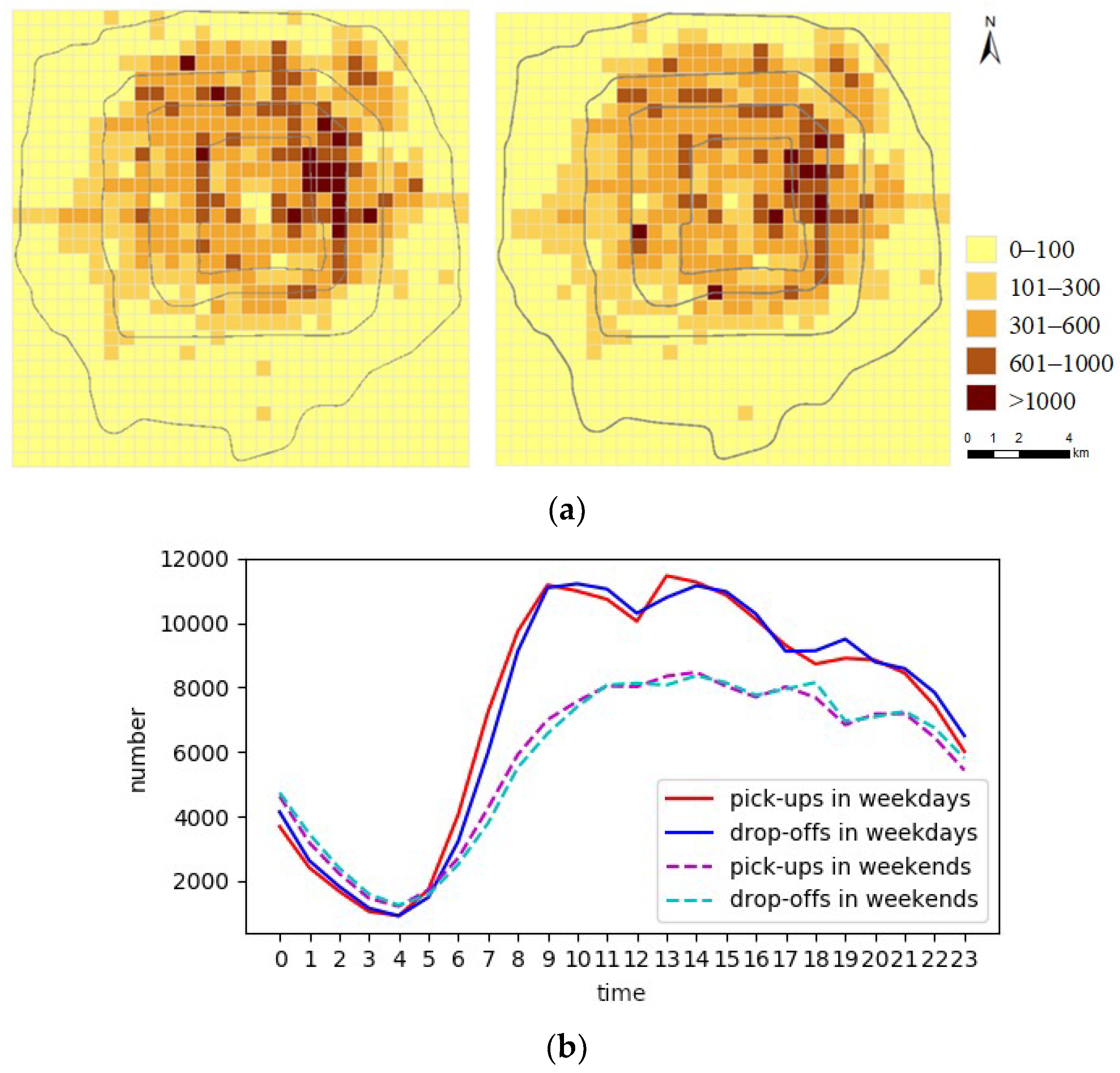
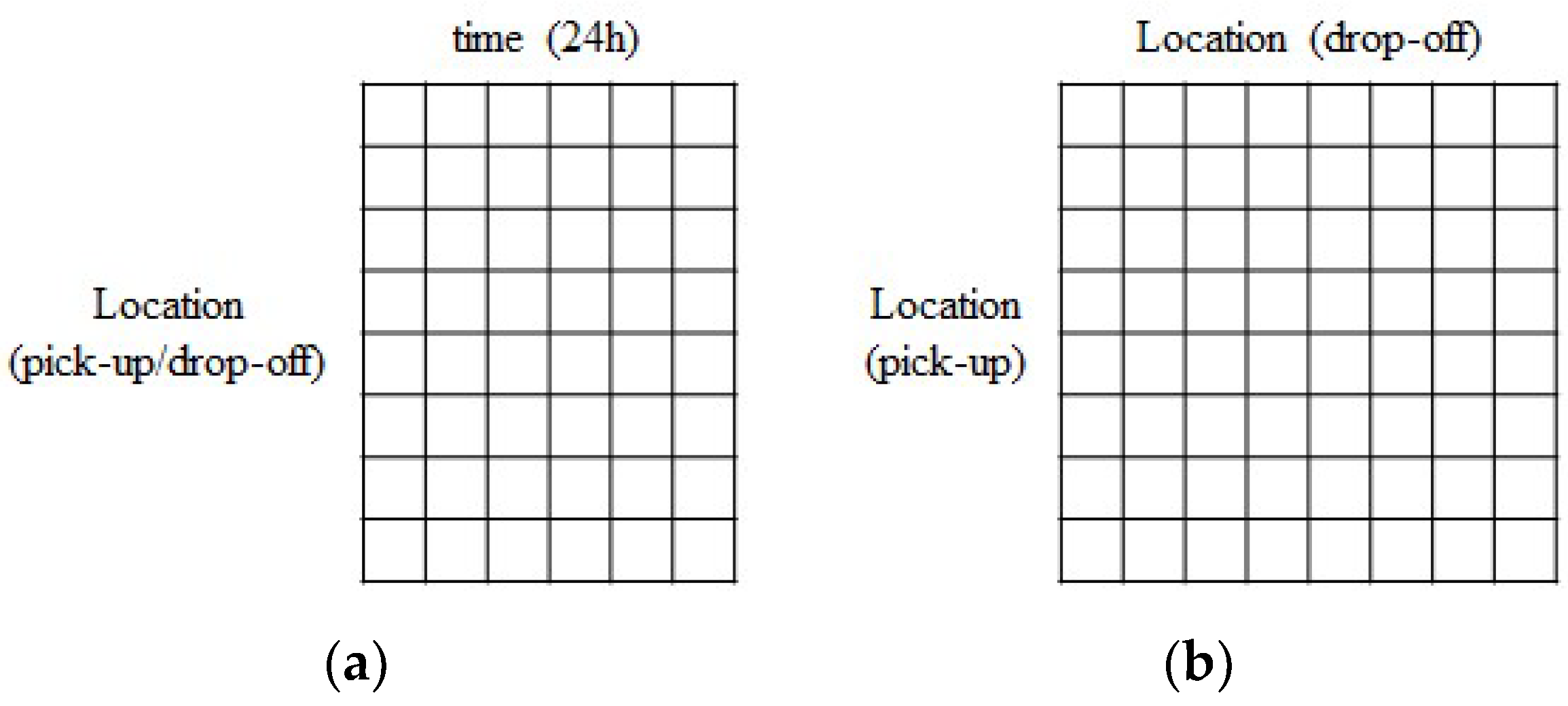
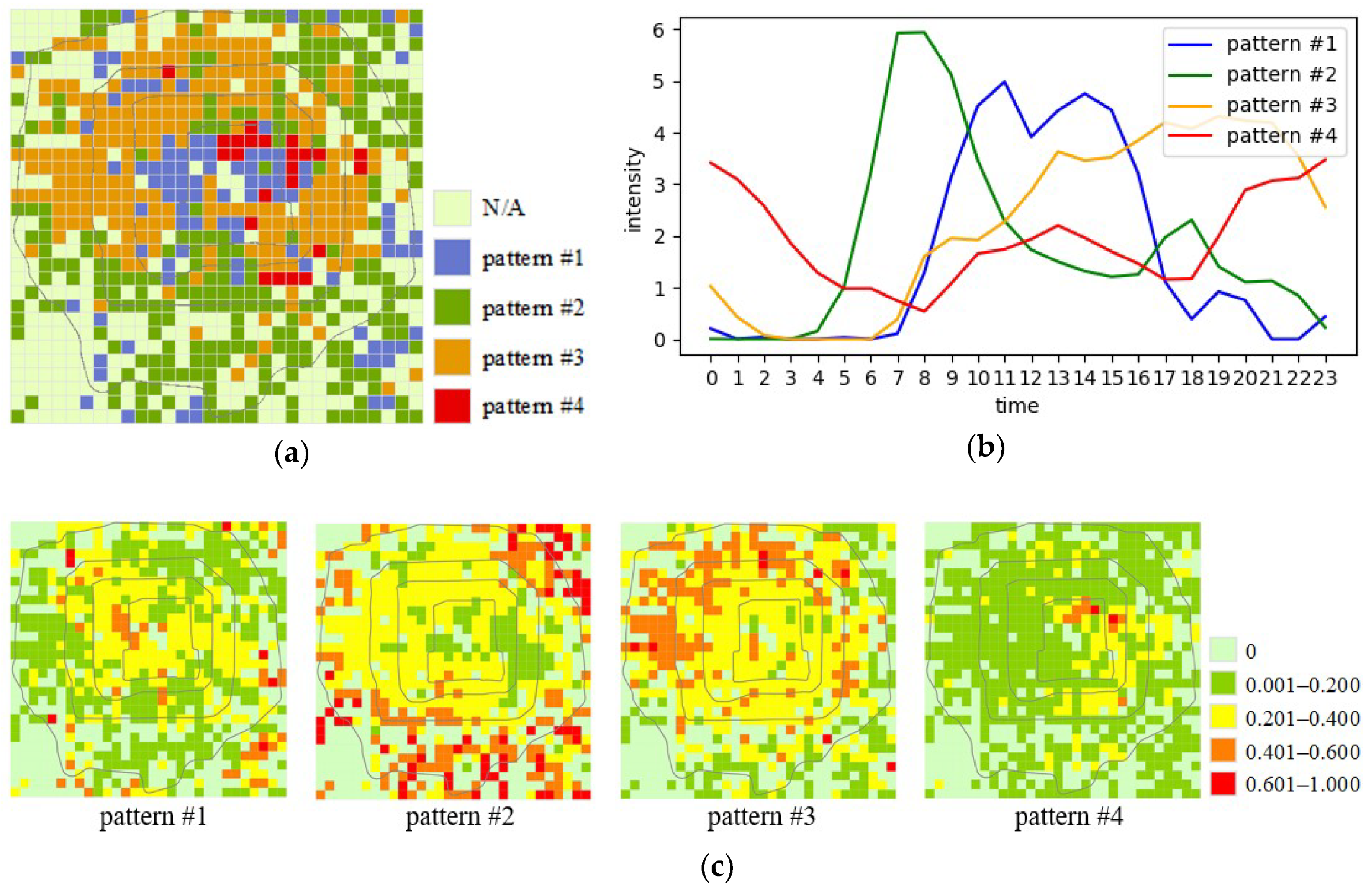

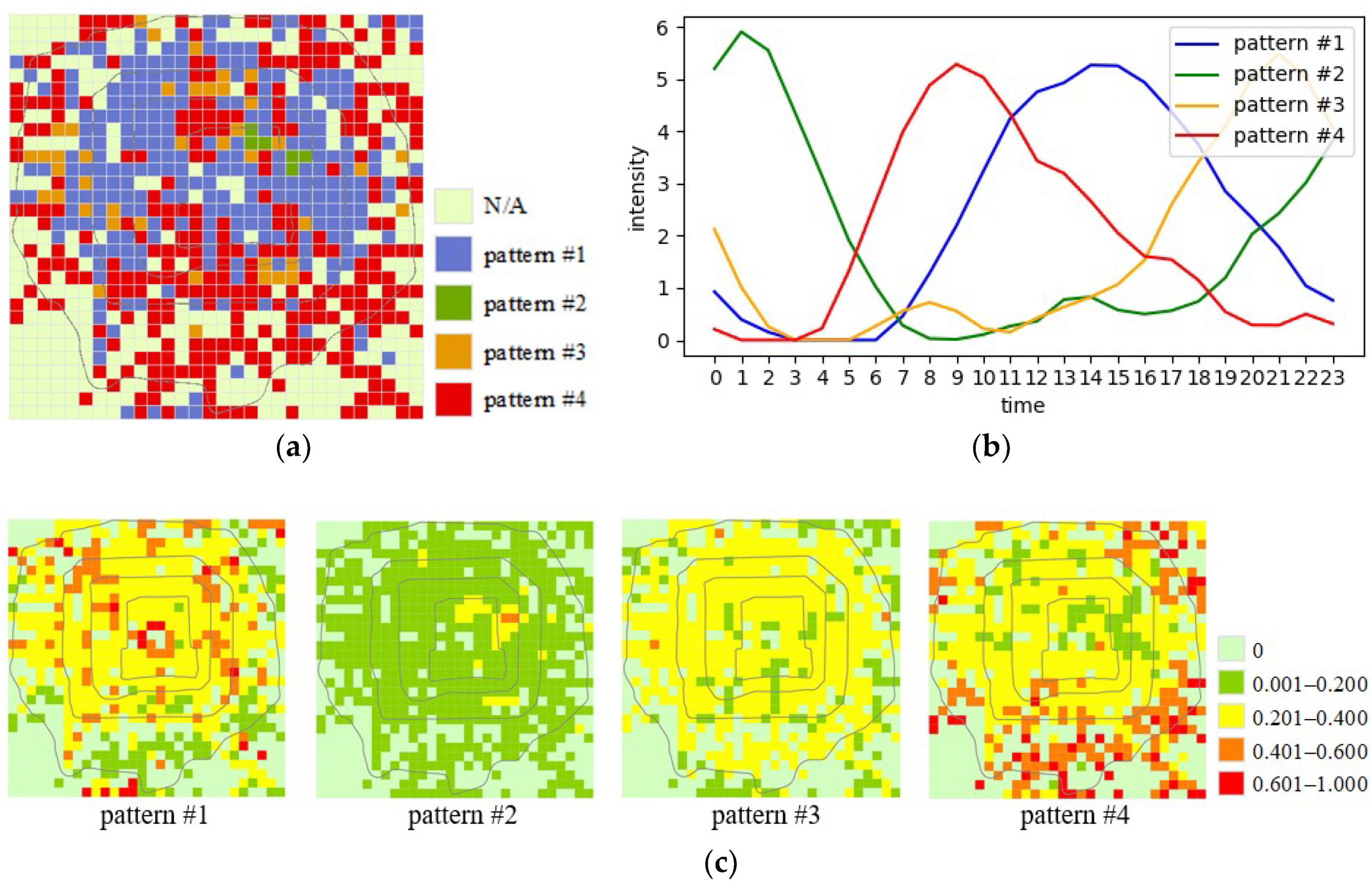

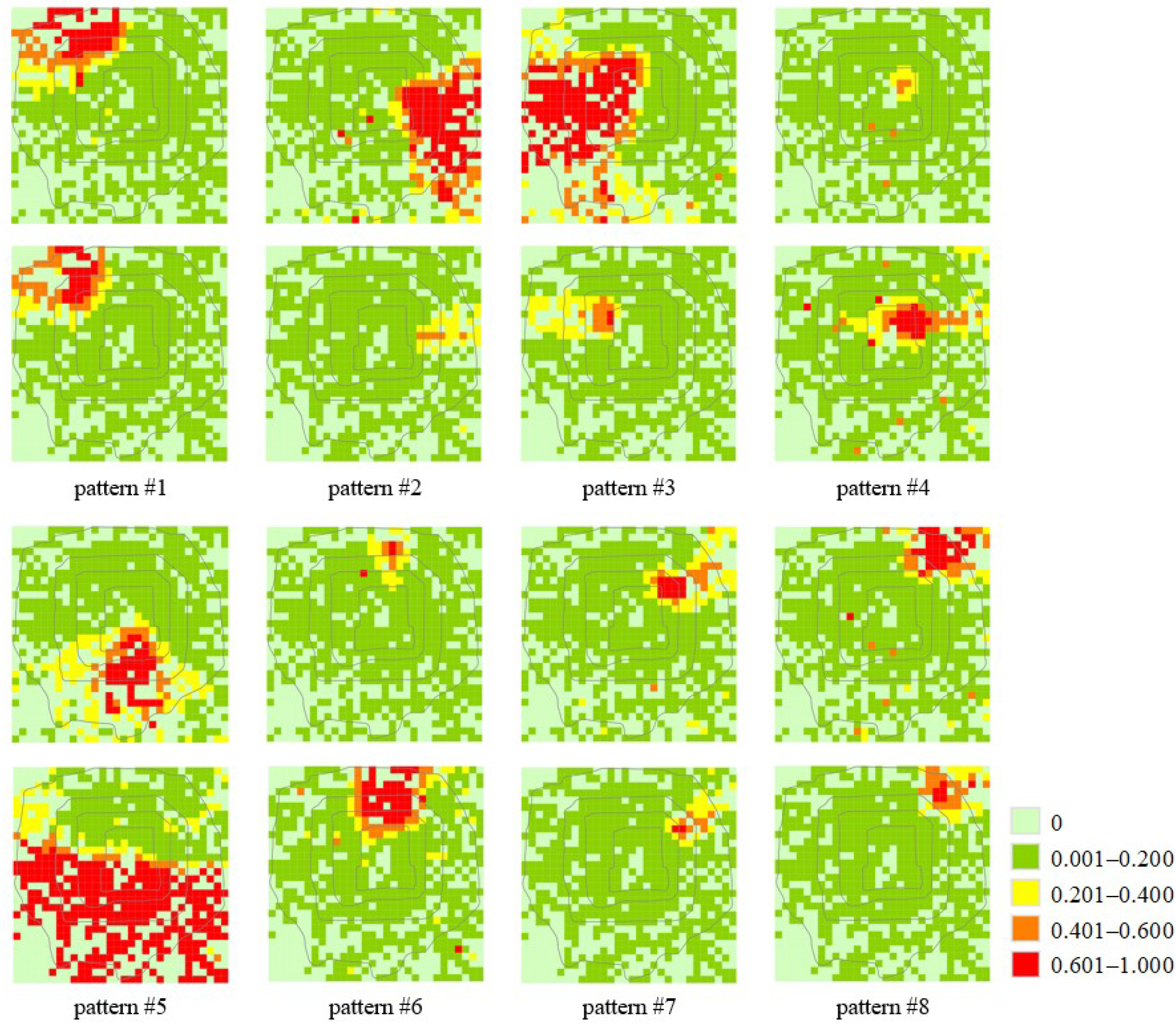
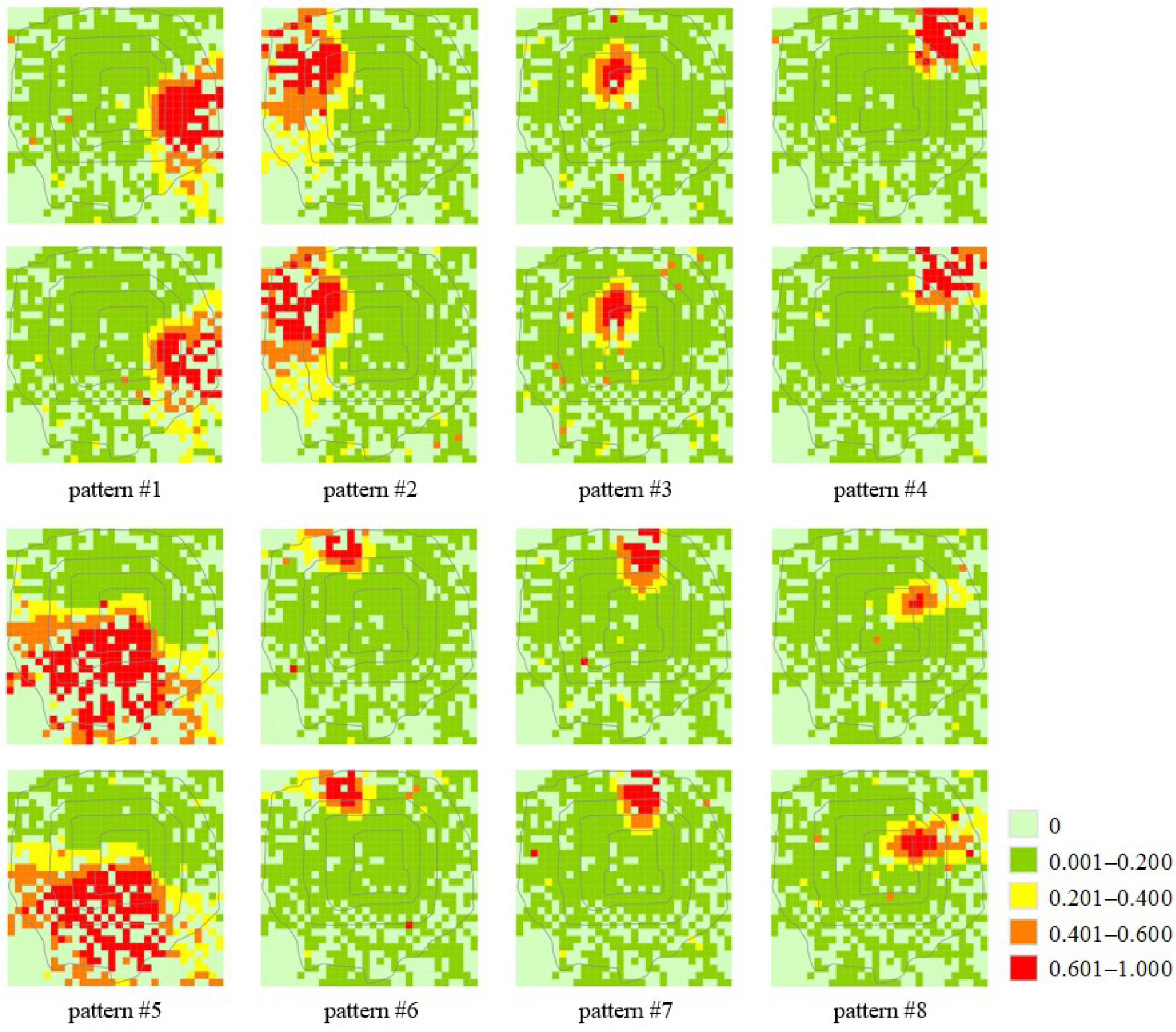
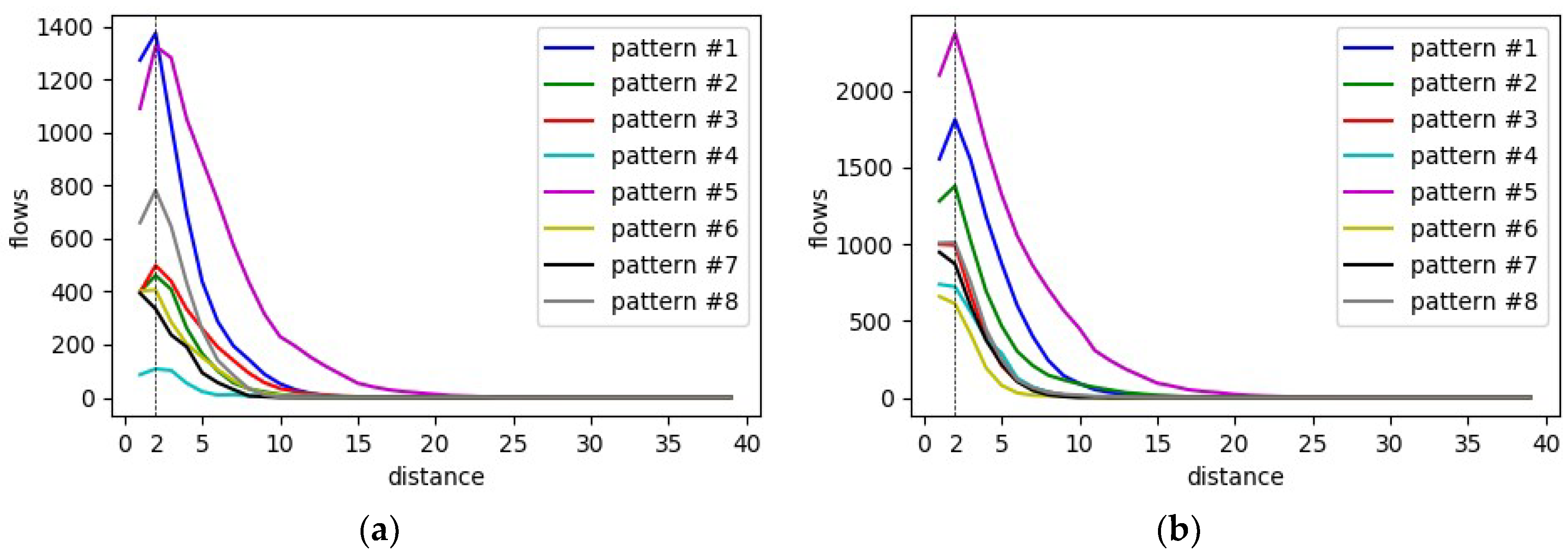
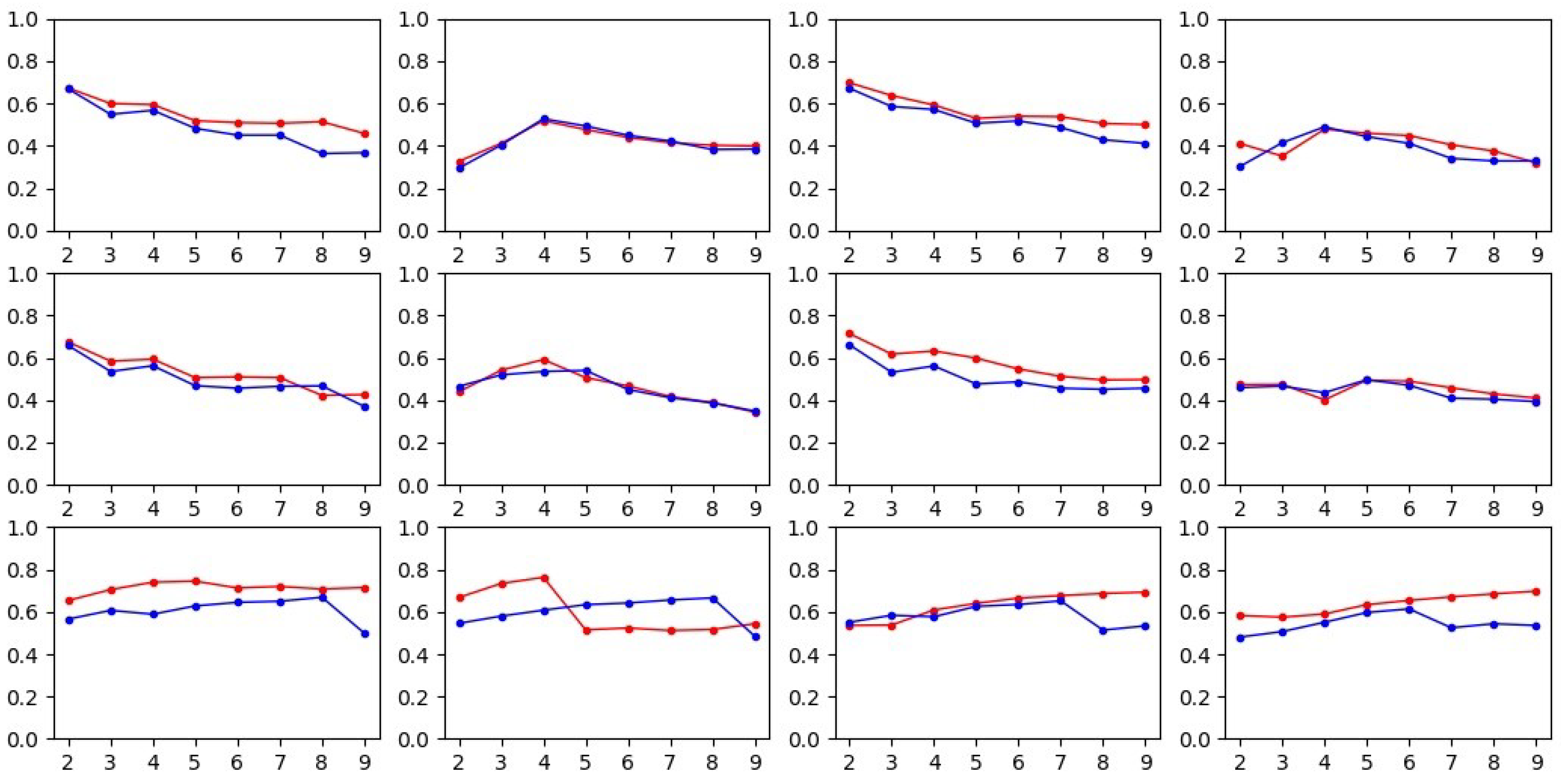
| Period | Mobility | Spatial Interaction Patterns | |||||||
|---|---|---|---|---|---|---|---|---|---|
| #1 | #2 | #3 | #4 | #5 | #6 | #7 | #8 | ||
| workday | departure | 8.00 | 15.33 | 21.22 | 0.67 | 7.67 | 1.00 | 2.89 | 6.22 |
| arrival | 6.78 | 0.56 | 1.56 | 5.22 | 34.56 | 7.78 | 1.11 | 3.00 | |
| major flow | 5.56 | 0.56 | 1.44 | 0.33 | 6.56 | 1.00 | 0.44 | 3.00 | |
| weekend | departure | 10.89 | 11.44 | 3.56 | 5.44 | 26.33 | 3.33 | 3.89 | 2.00 |
| arrival | 8.22 | 12.67 | 4.33 | 5.11 | 23.56 | 3.44 | 3.67 | 4.67 | |
| major flow | 6.89 | 10.00 | 3.00 | 4.00 | 18.89 | 2.56 | 3.11 | 3.89 | |
© 2019 by the authors. Licensee MDPI, Basel, Switzerland. This article is an open access article distributed under the terms and conditions of the Creative Commons Attribution (CC BY) license (http://creativecommons.org/licenses/by/4.0/).
Share and Cite
Gao, Y.; Liu, J.; Xu, Y.; Mu, L.; Liu, Y. A Spatiotemporal Constraint Non-Negative Matrix Factorization Model to Discover Intra-Urban Mobility Patterns from Taxi Trips. Sustainability 2019, 11, 4214. https://doi.org/10.3390/su11154214
Gao Y, Liu J, Xu Y, Mu L, Liu Y. A Spatiotemporal Constraint Non-Negative Matrix Factorization Model to Discover Intra-Urban Mobility Patterns from Taxi Trips. Sustainability. 2019; 11(15):4214. https://doi.org/10.3390/su11154214
Chicago/Turabian StyleGao, Yong, Jiajun Liu, Yan Xu, Lan Mu, and Yu Liu. 2019. "A Spatiotemporal Constraint Non-Negative Matrix Factorization Model to Discover Intra-Urban Mobility Patterns from Taxi Trips" Sustainability 11, no. 15: 4214. https://doi.org/10.3390/su11154214
APA StyleGao, Y., Liu, J., Xu, Y., Mu, L., & Liu, Y. (2019). A Spatiotemporal Constraint Non-Negative Matrix Factorization Model to Discover Intra-Urban Mobility Patterns from Taxi Trips. Sustainability, 11(15), 4214. https://doi.org/10.3390/su11154214





